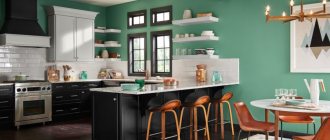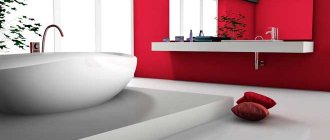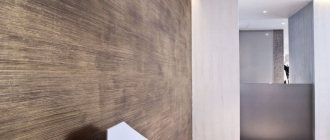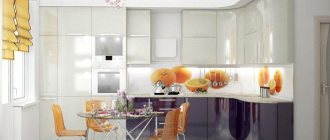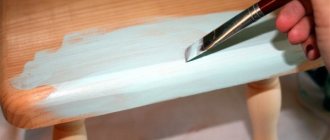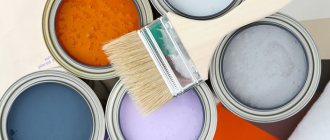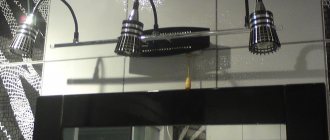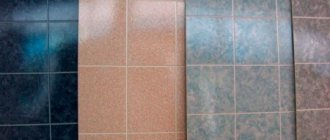Click to share
more
Tiles are not the only material that can be used to cover bathroom walls. Paints are a cheaper and increasingly popular alternative. However, when choosing them, you need to pay attention to the parameters of the emulsion so that it guarantees proper coverage and is resistant to moisture. So what paint to choose for painting a bathroom and how to paint it correctly?
Types of paints for painting bathroom walls
The main rule when choosing paint for painting walls in the bathroom is to purchase a material that is resistant to moisture. It is important that the painted surface can be washed with detergents in the future and that it is resistant to bacteria or mold.
Paints that will make painting bathroom walls a good solution:
Acrylic paint
Thanks to acrylic paint, a coating is applied to the wall that allows air to pass through perfectly. These paints are durable but will only cover the smallest scratches or imperfections on the wall.
Latex paint
This type has better coverage than acrylic paints, while maintaining good breathability parameters. The coating is resistant to washing and abrasion.
Ceramic paint
Thanks to ceramic paint, you can get a perfectly smooth coating. The advantage of this solution is that dust and dirt do not settle on the walls. Ceramic paints are also characterized by good adhesion and durability, as well as a delicate shine.
The best finish for bathroom paint is semi-gloss or high-gloss paint. Both options will add a shine to the surface, which will help the paint not absorb excess moisture, which leads to mold growth.
Semi-gloss paint contains more resin and binders than flat paint, and a high-gloss finish increases the amount of resin even more. As a result, you get a very dense molecular structure in these paint formulas. This is important when painting a bathroom for two reasons:
- The paint repels moisture. Instead of absorbing moisture and allowing it to collect and turn into mold and mildew, a wall painted with semi-gloss or high-gloss paint is more likely to evaporate the moisture.
- A harsher formula is better for surface cleaning. No doubt you like to keep your bathroom clean. Semi-matte or gloss paint finishes will withstand your bathroom cleaning and sanitizing efforts with less wear and tear on the paint.
What rules should be followed when choosing the color of the walls and the overall design?
Below are tips to help you navigate.
- It is not recommended to use gray or similar tones, since a bathroom, especially without windows, is considered a room where high humidity prevails. Color can add a bad mood. Ash and other similar shades are best used in large spaces where there are sources of natural light.
- If the color is chosen incorrectly, a bathroom, especially a small one, can visually shrink even more.
- Lighting must be properly organized, because it is in the bathroom that people clean themselves up and do their makeup. An important role in the comfort of these procedures is played by the decoration of the walls, as well as their color scheme. The selection of light and color should be a harmonious combination.
- The bathroom is a place for relaxation, so the color scheme should be pleasing to the owners, because their emotional state depends on it.
Good paints for bathrooms
Paints that work well in bathrooms have several key characteristics:
- Inhibiting Properties : Bathroom paint contains antimicrobial additives that help resist (but do not completely prevent) mold.
- Washable Finish: Because bathroom walls need to be wiped down or even scrubbed from time to time, a good bathroom paint is a little tougher and more resilient than other interior paints.
- Dense Structure: Some paints have a denser structure, which can cause gloss paints to perform as well as higher gloss paints in high humidity environments.
Matte or glossy surface
In the photo with various ideas for bathroom design for painting you can find glossy or matte finishes. The choice largely depends on the style of the interior or the size of the room.
Gloss is well suited for modern interior styles; this coating is especially impressive in hi-tech or minimalism. Shiny surfaces are also appropriate in small spaces, making the space brighter and wider. And if you add mirrors and distribute the light correctly, the effect will only intensify. Gloss makes stains, stains, and dust easier to see; such a bathroom will require more careful maintenance.
Matte walls are often chosen for the design of spacious rooms. Such decor looks more relaxed, visually reducing the dimensions, making the interior more comfortable. Matte paint can hide minor defects that are clearly visible in gloss. This design is more appropriate for classics, Provence, eco-style, Mediterranean style, etc.
How much paint does a bathroom need?
Available bathroom paints are very effective, but the amount needed still needs to be assessed on an individual basis. Manufacturers indicate on the packaging how many square meters can be covered with 1 liter of this product.
To buy the right amount of paint for a specific room, measure the height and width of the walls and multiply both values by yourself. This way you will get the number of square meters you intend to paint and can choose the right package size or number of packages.
Consumption of paint and additional materials
Any paint has such an indicator as hiding power. It indicates the number of grams of mixture that must be applied to 1 m² of surface to obtain the color of the desired intensity. To calculate the consumption of materials, multiply the hiding power by the surface area that will be painted, and divide the resulting value by the volume of 1 can. The result is rounded up and the number of cans of paint that needs to be purchased is obtained.
To calculate the amount of putty, calculate the consumption rate of the selected mixture per 1 m² (indicated on the packaging), the thickness of the applied layer and the area of all surfaces that need to be leveled. This data is multiplied, the resulting number will indicate how many kilograms of putty will be required.
Paint consumption.
The required amount of primer is also determined by multiplying the consumption rate by the thickness of the layers and the surface area of the coating. Using the same formula, the required volume of paint is calculated.
Bathroom paint - one or two coats?
This question arises very often, especially among novice painters. There is a clear answer to this, because everything depends on the manufacturer’s recommendations. Information on this should be found on the packaging of the selected paint, although most manufacturers recommend applying the paint in two layers at a certain time interval.
The vast majority of professionals share the same opinion. Only with two layers can you obtain and retain all the properties of paints longer. However, in practice, walls can only be painted once. Much depends on the condition and type of surface and the skills of the painter.
How to paint the walls in the bathroom?
When painting bathroom walls, it's not just the type of paint that matters, but also how you use it . First of all, you need to thoroughly clean the surface of the wall. It is important to thoroughly remove dust, dirt and grease - a solution made from water and detergent will help at this stage.
It is also worth adding an antifungal agent . Cavities on dry walls should be filled with putty or gypsum plaster. Then it’s worth sanding the wall thoroughly and vacuuming the entire room.
The ideal temperature for painting bathroom walls is 20-21°C . Painting should start from the ceiling. The second coat of paint is applied only when the first is completely dry.
Which paint to choose
The durability and appearance of wall painting directly depends on the type of paint composition chosen. Before deciding which paint to choose for your future bathroom, you need to consider the following factors:
- the degree of humidity in the future bathroom and the actual state of ventilation;
- ease of use - how well the paint adheres to the walls, drying time, presence of odor;
- the type of coating chosen - gloss, matte, textured, and how well it matches the style of the bathroom;
- the desired color scheme - many paints change shade when dry;
- illumination of the room - in bright or, on the contrary, too dim light, the tones of colors are visually distorted.
When using light shades, less light is required.
Should you paint your bathroom walls?
Painting bathroom walls is a cheaper solution compared to tiling. This is also a way to create an original bathroom finish. Some people prefer to combine these two methods. Tiling one wall and painting the rest is a compromise that combines the most popular forms of bathroom finishing. A good solution is to tile sections of the walls near the sink, bathtub and inside the shower stall.
To optically enlarge a small bathroom, the best solution is to use light-colored paints. For larger surfaces, you can choose bolder solutions - even black or dark brown. Bathroom wall paints offer virtually endless design ideas.
Choosing KM for room design
The choice of paint and varnish is influenced by the design of the room.
Color
The choice of color adapts to the interior elements. The main thing is not to disturb the harmony of the design. Today, only white, blue or light shades of dye are no longer chosen. Mother-of-pearl paints of contrasting shades are applied, or matte colors of violet, lilac, and blue are combined.
Matte or glossy
The water-based emulsion gives the surface a matte finish. The shades look saturated and the room looks muted.
Varnish and metallic compounds give the surface a glossy finish. A space with such a coating visually expands. The room acquires lightness and respectability. For a small room, shades of coffee with milk, pink, turquoise, azure, and blue are recommended.
Designers sometimes combine painting KM walls in one room, which give a matte and glossy look. In large rooms, a combination of light and dark colors is used.
Painting the walls in the bathroom - how to do it?
Painting is a simple activity that anyone can do on their own. The only problem may be the condition of the floor (walls and ceiling). There are situations when preliminary preparation of the surface for painting from scratch is required.
If the walls are very uneven or have many cavities, it is best to cover them completely with gypsum plaster or use dry plasterboard paneling. Such a smooth surface will give a lot of relief with each subsequent painting. Then it is enough to apply putty to the existing defects, sand off the excess, prime the walls and apply the chosen paint.
Before we start painting, we protect the elements in contact with the surface to be painted from contamination. Masking tape is used for this. It can also be used to separate walls from ceilings and color from color to create perfect cuts.
Paint from the selected corner. Here the paint is best applied with a round brush. To paint the rest of the walls, you should choose a roller because it requires less paint and creates a more beautiful finish.
Wall decoration
A solid color looks neat and advantageous. You can make your bathroom more interesting and give it an unusual look with additional decoration.
Coloring with stencils
Light patterns, ornaments, images of animals or objects can simply be applied with a stencil.
Blanks can be purchased ready-made, ordered, or made on your own.
For even application, the stencil is secured with tape to a dry wall.
Stripes on the walls
Horizontal stripes will visually expand the room, vertical stripes will save you with low ceilings.
Contrasting colors and similar shades look interesting.
To ensure that the lines are straight, markings are applied using a plumb line or a building level. Apply masking tape along the marked lines.
It is removed when the paint has set slightly, before it begins to dry, so as not to damage the integrity of the coating.
Applications using rollers
There are rollers with convex patterns.
First apply the base color, then dip the roller into the paint. It needs to be rolled out well before application.
It is important to ensure that the drawings do not overlap each other, otherwise the wall will look sloppy.
The best paint for bathroom ceilings
Look up - your bathroom ceiling needs painting too. While you may be tempted to apply a cheap and quick coat of white, the best paint for bathroom ceilings is one that will resist moisture and mildew.
Choose matte or semi-gloss paint for your bathroom ceiling. You can opt for a satin finish if you don't want to attract too much attention overhead.
However, if you enjoy hot showers, you'll want to opt for a more durable and water-resistant semi-gloss finish. It's common to see water stains on the ceiling due to moisture condensation in this damp area of the house, and semi-gloss paint is better at preventing mold growth.
For your information
Never paint over mold. Before painting your bathroom, you must take steps to remove mold and seal it to prevent mold growth and problems in the future. The typical method is to use a water solution and bleach to remove mold from the walls and ceiling. Be sure to wear a respirator and gloves during this process and keep the room well ventilated.
How to paint it yourself?
Before starting work, you need to prepare the necessary tools and materials:
- dye;
- putty;
- primer;
- sandpaper;
- film to protect plumbing fixtures and floors;
- paper tape;
- protective equipment (respirator, safety glasses and gloves);
- pallet;
- rollers of different sizes;
- brush.
If everything you need is available, you can start painting the walls.
How to properly prepare the walls?
The paint will adhere well only to an ideally prepared surface, so minor repairs are indispensable.
- Remove the old covering. If it's tile, knock it down and remove any remaining mortar.
- Wash the walls to remove dust.
- If the surface has significant differences and unevenness, then everything will have to be leveled with plaster.
- If there are small defects on the wall, putty them first. Let it dry and only then treat the entire wall. It is important to choose a moisture-resistant putty (for example, latex-based).
- Once completely dry, go over it with sandpaper to remove any rough edges.
- Remove any remaining material and dust particles from the surface using a damp cloth and broom.
- Carefully prime the walls with a waterproofing compound in accordance with the instructions. A new layer cannot be applied until the previous one has completely dried.
The photo shows the dismantling of old tiles
Step-by-step instruction
The surface is prepared, painting can begin.
Advice! It is better to pour all the paint you are going to use into a large container and mix. Paint of the same color from different cans may differ in nuances. By mixing them together, you will get a uniform shade.
- Measure the area of the bathroom walls. Calculate how much paint you need based on the information on the label, add 10-15% of the amount received in reserve.
- Remove covers from outlets and switches and cover them with masking tape. Don't forget to turn off the power before doing this.
- Also seal the boundaries of the walls with the floor and ceiling with tape. Place a film on the floor to protect the floor.
- Stir the paint so that there are no lumps left. If you added color, make sure there are no streaks.
- Pour it into the tray.
- Use a brush to paint corners and hard-to-reach places.
- Dip the roller into the tray and roll it several times to ensure the paint is evenly distributed without gaps.
- Start painting from the corner so that each strip overlaps the previous one by 2-3 cm.
- Proceed with applying the second layer only after the first has completely dried.
- Remove the tape before the paint dries, otherwise it will come off with it.
Video
Bathroom paint - what haven't we talked about yet?
Did you know that when painting your bathroom you should consider how the color will affect your specular reflection? Right. The wrong color can change the appearance of your face, making it difficult to get ready for the morning. Choosing a neutral color - white, cream, pastel, gray - often solves this problem.
Bright blue or green colors can give your skin an unnatural glow after exposure to natural or artificial light in the bathroom, exacerbating dark circles and blemishes.
If you're planning on taking a long bath, colors like taupe, sage and dusty blue are ideal for creating calm. There's a reason spas use these muted, nature-inspired hues in their decor—they evoke a sense of zen calm and invite relaxation.
If you want your bathroom to look more lively, use a variety of shades of white, from bright to cream. No color says "clean" like white, and you can always add touches of color with decorative tiles or, for maximum versatility, accessories like towels and rugs.
Ideas for inspiration
Is it difficult to combine shades? Take a bright tile with a print as a base: it already has all the colors that can later be used on other surfaces to achieve color harmony.
If the room is supposed to use a wooden texture, on the contrary, in order not to make a mistake, give preference to solid monochrome shades: white, beige, gray, black.
Bathroom paint price
Bathroom paint generally refers to individual interior paints, excluding overpriced designer paints. You can expect to pay about the same or a little more than for standard premium paint, or about RUB 1,800 per can. The good news is that you will get high quality paint that will last in your bathroom. And fortunately, the bathrooms are relatively small.
more
Video:
Comments (3)
- Svetlana May 22, 2022 at 04:03 pm
What paint do you like?
Answer
- Natalya May 27, 2022 at 04:50 pm
I painted a bathtub a year ago with dulux paint and was very pleased. The paint is lump-free and dries quickly. Besides, it can also be washed, it’s totally cool.
Answer
- Evdokia December 12, 2022 at 7:56 am
thanks for the advice
